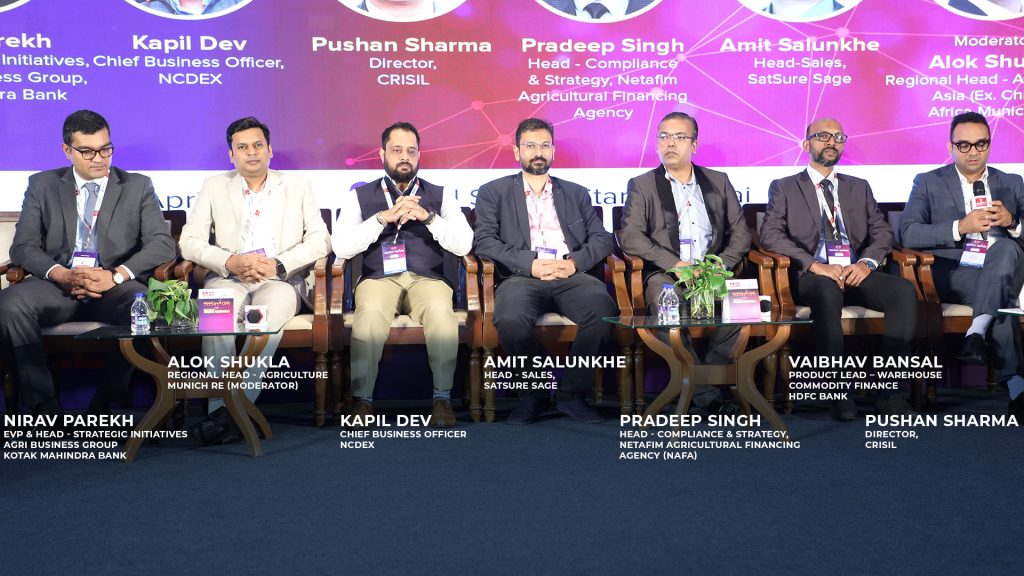A revealing panel discussion at Technoviti 2023 organized by Banking Frontiers:

Panelists:
- Vivek Manchanda, Head – Digital Banking Space, YES Bank
- Sumanta Panda, GM – IT, YONO, State Bank of India
- Nitin Nagarkatte, COO, Montran India
- KV Dipu, President – Head Operations, Communities & Customer Service, Bajaj Allianz General Insurance
- Krishnha Sheshan, Sr VP & Head – Products & Implementation, Digital Payments & Acquiring, RBL Bank
- Srivaths Varadharajan, COO, Spice Money
- Sushil Thakur, Director – Technology Consulting, Financial Services Advisory, EY India (Moderator)
Sushil Thakur: How are you leveraging the mobile ecosystem for smart interaction with the users and how are you reaping benefits?
Sumanta Panda: All mobiles are now part and parcel of all our lives, more so in banking. Banking has evolved with the mobile ecosystem. For us, it starts with the registration process itself with SIM binding and some device credentials which get captured and that remains with the bank to identify that the mobile holder is the are the right person. Second factor authentication is also done using OTP or device based biometric. We also have video KYC based account opening which uses the camera, speaker and contacts of the mobile device. Banks use the mobile location information to inform customers where they can get access to branch, ATM, POS, etc. So there are multiple uses of the mobile ecosystem itself.
Similarly, customers profiles and their activities are analyzed to identify who are the customers and what are their uses. Based on that, a lot of campaigns are initiated, and in these campaigns, customers are nudged real time about various products and better ways of using banking services. Similarly, time and channel information can be used to optimize messages and alerts.
Sushil Thakur: How is the product development team at your organization tackling these kinds of changes?
Nitin Nagarkatte: Every product company has their own USP. Montran is very different because of the way we work. We have 2 products – one is an infrastructure product and the other is a commercial banking product. When we do infrastructure products like RTGS and ACH, it creates an ecosystem for the country and that really helps us to build our commercial bank products. So whatever changes happens at the central side becomes very imminent and easily enables the commercial bank product. We are present across 80 countries. The other thing is we need to really look at how the payments digital transformation has really, really scaled. So the underlying system architecture has to be flexible to handle volume growth and for system changes. We ensure that we are making a product not only for the next 2-3 years, but for many years. We have a layered of architecture of which really helps us in customization.
Sushil Thakur: With the increase in digital also comes the risk of fraudulent transactions and phishing attacks. What are the challenges that need to be tackled in these situations?
Krishnha Sheshan: The awareness has been created by Jamtara, a series on Netflix. A 2021 report by Microsoft says that 42% of financial transactions have a fraud instance that an Indian customer has encountered, and 70% of the money has not been retrievable. So as digital technology grows, it is important is to build confidence and caution so as to build trust in digital transactions. India has been dealing with this very well, both at a policy level and the process level.
We have limitation liability circulars plus harmonization of TATs, etc, to arrest the fraudulent transactions. Obviously, the information and knowledge are very important. There are a lot of guidances and imperative communications from regulated entities to make the customer aware that he has done the transaction. In addition, a lot of financial organizations do monitoring.
NPCI has been very innovative in developing a real time issued resolution mechanism like the UDR. What I think is important is the laxity – because we in pursuit of convenience, we sometimes forget to give attention to the message that is coming to us.
Sushil Thakur: Where do you think is the mobile payment industry headed?
Vivek Manchanda: I think there are 5 factors which have contributed majorly to the push of digital economy in the country. One is mobile networks and mobile data becoming really cheap. Second is demonetization. Third is UPI, and fourth is smart phones becoming really cheap. Fifth, we are the youngest economy in the world. With these 5 factors, we have a lot of youngsters who are using mobile phones now and they are not averse to using technology. Also we have had RBI and NPCI pushing people towards using mobiles more frequently. Even a vegetable vendor has a QR code. UPI is seeing 8 billion transactions every month compared to 1 billion transactions about a year back.
Other than the smartphone, people are cognizant of the fact that 61% of the population is rural India and probably do not have smartphones available with them. So we have seen new features introduced again by and NPCI on UPI. So you have a UPI 123 available. Also, UPI Callback for feature phone users.
Sushil Thakur: What are some of the derailment factors of digital first insurance, and what proactive measures can be taken to address these?
KV Dipu: We need to take cognizance of the fact that in India we speak several languages. Sometimes the tendency is to launch digital assets only in English. We need to ensure that assets are reconfigured to amplify our reach to people who speak various languages, so that we can connect with the customer in the platform where he’s comfortable speaking his native tongue. Otherwise you will have this divide between digital haves and have nots. The second aspect is security. Financial service is a matter of trust. It is important for all players across the board to ensure strong security so that customers feel that they can go about the transactions in a secure manner. If you do not trust the system, then scaling up becomes very difficult.
Third, there are fluctuations in bandwidth across the entire country. You may have an asset, but if you do not have the bandwidth to cater to that, then it’s going to be a nonstarter. So depending on network speed, we also have light versions of the apps. The fourth angle is the tendency to move from 100% manual to 100% digital. It may not happen overnight. You may need to have a handholding stage in between, where you focus on assisted digital. So if we can take care of these factors, we can prevent derailment of the digital transformation journey.
Sushil Thakur: How is the digital ecosystem of financial institutions addressing the requirements of a rural economy? How can policymakers and regulators collaborate on this?
Srivaths Varadharajan: What is important is when you talk about digital ecosystem, you need to serve the B2C customer in the end. You might have a lot of intermediaries, but the end customer who are going to consume the products are going to be the end consumers. When we say rural, 61% of the population is staying in rural economy, and about 44% population using smartphones. In the digital ecosystem in rural India, it is largely an assisted journey. The reason is that the trust factor has yet to come into the system, because most of the banking products are quite complex for these customers. So the merchant platform plays a very important role for the rural economy, where they have a complete assisted platforms through which they have created capabilities like AEPS, domestic money transfers, etc.
The regulation doesn’t divide between rural economy and urban economy and the risk is same whether for both. Most of the regulation focus and concentrations are on the financial services and institutions who have passed those on to the banking correspondent. Regulation is focused towards financial services looking at infrastructure, databases, processes, policies, check systems, including the other intermediaries who play a critical role.
 In Spice Money, we have around about 1.2 million merchants, and we have served around 1 billion transactions through our platforms. In the back end, we have our banking and financial services ecosystem.
In Spice Money, we have around about 1.2 million merchants, and we have served around 1 billion transactions through our platforms. In the back end, we have our banking and financial services ecosystem.
We must understand the banking products are built more from the tier 1 & 2 perspective. It has become more of a one size fits all. Income in rural economy is very different from urban economy in terms of savings, deposits, investments, etc. So that needs to be a lot of change when it comes from the banking product ecosystem to serve the rural masses through sachet kind of products.
Sushil Thakur: How are financial institutions are addressing ESG? What are some of the enablers from the technology or fintech perspective, as well as from the policymakers and regulators perspective?
Sumant Panda: Banks are really looking at improving the sustainability index, where in the environment that we are working on and that comes from aligning the various banking products which will create sustainability and improvement in the environment and aiming towards the carbon neutrality.
Any green banking product from the deposit perspective should also be aligned. Banks must look at what technology is being used by the companies for manufacturing, and whether it is aligned towards better efficiency and creating the employment generation in the best possible way up for sustaining the environment.
Nitin Nagarkatte: Let’s look at the condition where there’s a spike of transactions happening. You cannot think about having a set up a huge hardware for a long period. So how are the spikes and all are being managed, such as spikes resulting from IPL matches? There is always this challenge – how we ensure that with minimum of the hardware and the systems, we reduce the footprint across the globe and able to meet up with the scale of the transactions which are happening.
Krishnha Sheshan: Everybody plays their own part in ESG from a corporate level and product level. As digital transactions grow multifold, the resources consumed in terms of hardware, software, etc, will need also to be looked at dynamically. In fact, most of the organizations are moving to cloud. So shared services is one way.
Vivek Manchanda: As a bank we publish our ESG report every year. So we want to be one of the greenest banks in the country. We track how many of our processes we can share with the partners and scale up. Also, how we dispose of our electronics and electronic footprint is something that we manage very aggressively at the bank.
KV Dipu: On a broad level, ESG brings the responsible elements of our corporate sector to the fore.
Srivaths Varadharajan: We are completely digital and paperless. We have put all system on a private cloud to optimize carbon footprint. We ensure that there is a minimum usage of electronics and paper, and we leverage the capabilities of our partners in the ecosystem who take more responsibility.
Read more:








